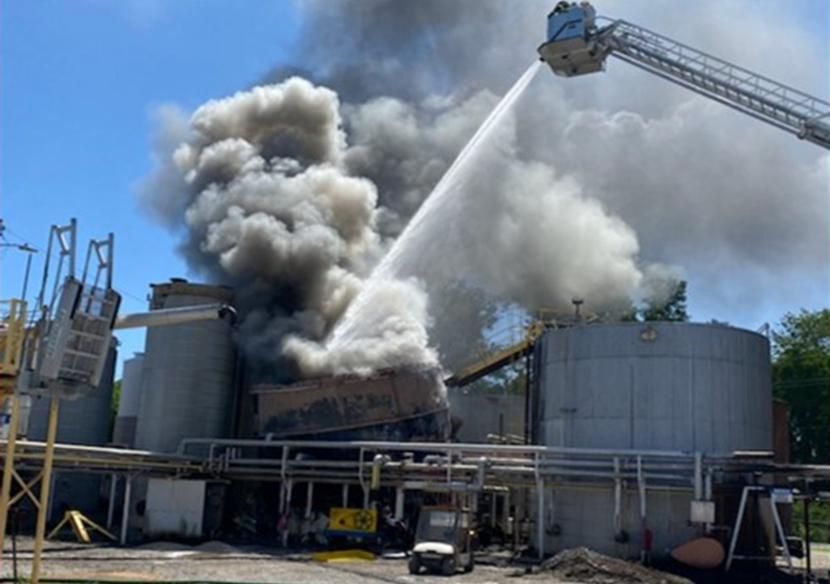“It always seems impossible until done.” — Nelson Mandela
There are dozens of motivational posters available that encourage us all to believe that we can do the impossible. They intend to inspire us to reach for the stars. But there is also a dark side to achieving the impossible.
It’s when the impossible we are considering is catastrophic. The RMS Titanic was supposed to be unsinkable. But on its maiden voyage in 1912, it hit an iceberg while crossing the North Atlantic Ocean, and it…sank.
There are many things that seem impossible until they happen, including certain catastrophes in the workplace. In the process industries, we worry about fires and explosions, and rightly so. Our focus tends to be on highly flammable liquids. For those of us in the St. Louis area, though, there have been several grim reminders recently that there are substances and conditions where other things—some unexpected—can also explode.
East St. Louis, Illinois – Sunday, July 10, 2022
At around 10 pm on a Sunday night, an indoor catalyst charging tank at the Allnex plant in East St. Louis exploded. The explosion injured two employees; both were taken to the hospital. One was treated and released the same day, while the other was admitted to the hospital with severe burns.
At the time, the fire department reported that the explosion involved a water-soluble chemical. The building housing the catalyst charging tank was equipped with an automatic sprinkler system, but the fire was above the sprinklers. Fire could be seen coming through the roof of the production building that night. In addition to damage to the roof of the production building, the structures around the catalyst charging tank were also damaged.
Later, Allnex reported that the chemical was a peroxide. Hydrogen peroxide is water soluble and is listed in Appendix A of the PSM standard at concentrations above 52%, because of its potential for catastrophic decomposition. Some organic peroxides are also water soluble and can be shock sensitive.
Hazelwood, Missouri – Thursday, June 9, 2022
Shortly before 11 am on a Thursday morning, personnel were unloading roofing tar from a rail car into a storage tank at Sprit Asphalt in Hazelwood, immediately north of St. Louis, when the vapors in the headspace of the storage tank ignited and exploded. Workers were able to disconnect the rail car and move it of harm’s way.
The top of the storage tank blew off during the incident. The Hazelwood Fire Department responded to extinguish the fire and to keep adjacent tanks cool and prevent them from igniting as well. The fire was considered extinguished after about 1½ hours. No one was injured.
Officials from the fire department concluded at the time that a spark inside the tank ignited the product that had been unloaded.
Saint Louis, Missouri – Friday, April 1, 2022
At around 9:40 am on a Friday morning, there was an explosion in the basement of Shawn’s Master Auto Repair in south St. Louis City. Witnesses observed a fireball shooting up out of the basement at the time of the explosion; the incident caused one wall and the roof of the one-story building to collapse.
There were six employees and a customer at the shop at the time. An employee was injured and taken to the hospital where he was examined and released. There were no fatalities.
The fire department was able to rule out a natural gas leak as the cause. At the time of the incident, an official from the fire department hypothesized that sparks from welding in one of the bays of the shop ignited an oil pan in the basement.
No Flammable Liquids
Fortunately, none of these incidents resulted in fatalities.
None of these incidents involved highly flammable liquids with low flash points, either. You know the type: liquids covered under the PSM standard with flash points less than 100°F, the type we associate with vapor cloud explosions. Like ethanol (FP = 55°F), methyl ethyl ketone (FP = 16°F), and toluene (FP = 39°F) .
Motor oil has a flash point in the range of 300 to 400°F. Not highly flammable.
Roofing tar has a flash point of at least 500°F. Not highly flammable.
Hydrogen peroxide is non-flammable, so doesn’t have a flash point. It is a powerful oxidizer, however. As for other peroxides, their hazard should be well recognized.
Somehow, the workplaces where these materials were kept created the conditions for them to explode. That there were no fatalities was a matter of luck.
Impossible?
Typically, the labels of flammable liquids with low flash points warn us about their hazards, reminding us over and over of the potential for fire or explosion. The labels of other materials, such as motor oil and roofing tar, carry no such warning. That doesn’t mean they are harmless.
Under ambient condition, the materials you work with may very well be as harmless as you think them to be, with a fire or explosion about impossible. But under other conditions, such as when heated, they may very well be a bomb waiting to explode. Consider the material you work with and the conditions they are at when evaluate what safety measures are appropriate.
